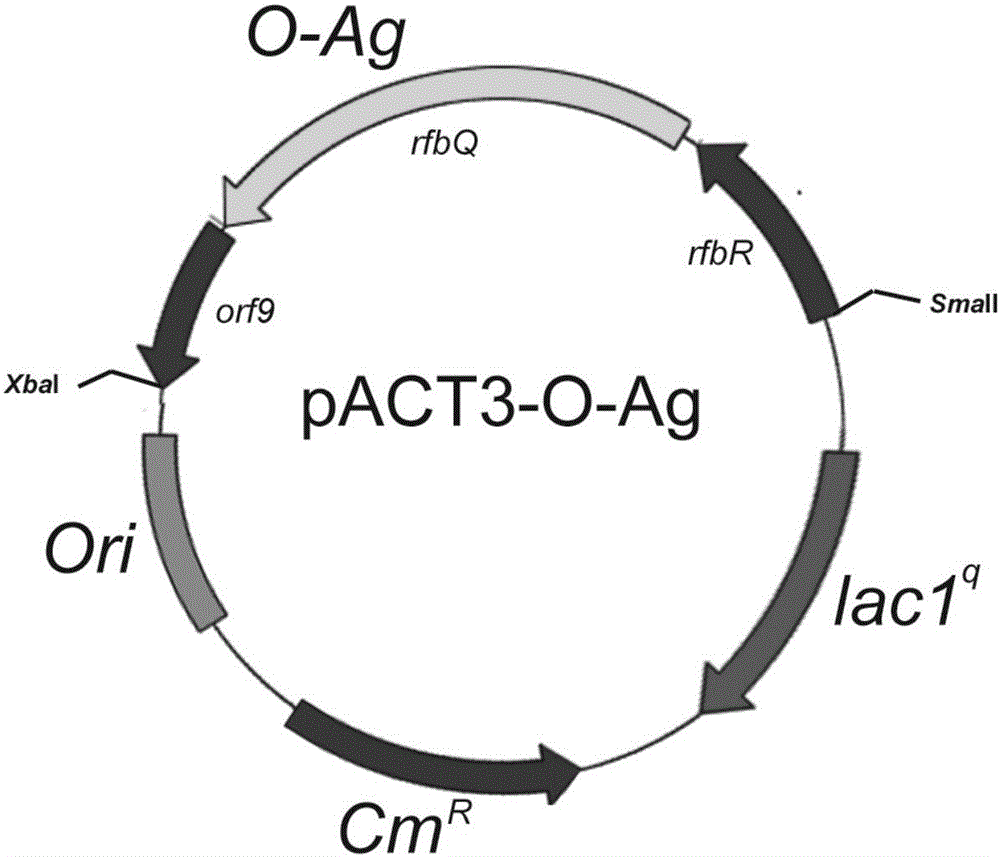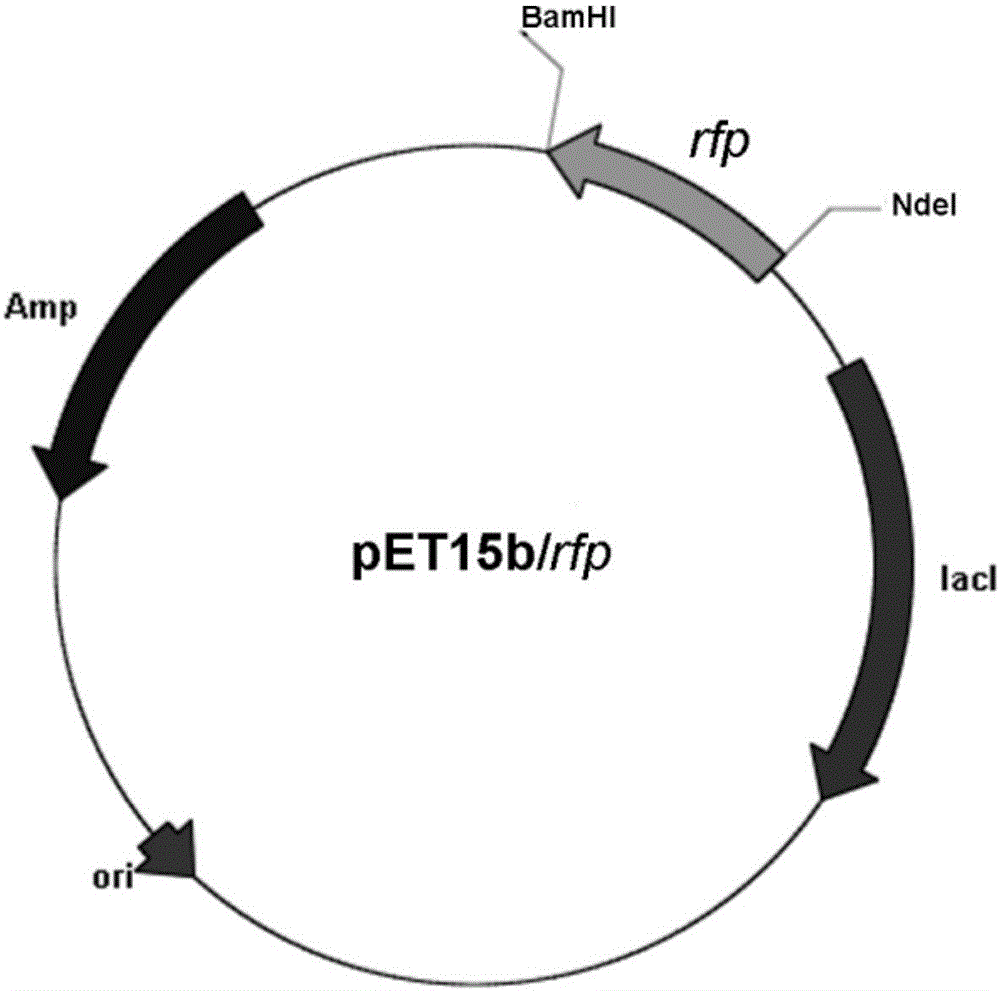Recombinant escherichia coli, and application of recombinant escherichia coli to preparation of anti-Shigella glycoprotein vaccine
A technology for recombining Escherichia coli and Shigella dysenteriae, which is applied in the field of glycoprotein vaccines, can solve problems such as difficult transformation, late transformation, and too large gene clusters
- Summary
- Abstract
- Description
- Claims
- Application Information
AI Technical Summary
Problems solved by technology
Method used
Image
Examples
Embodiment 1
[0035] Embodiment 1, the construction of O-Ag gene cluster expression vector
[0036] Primers were designed according to the genome sequence of Shigella dysenteriae type 1 pathogen published by NCBI:
[0037] S.d-F-SmalI: 5'-TCCCCCGGGATGAATAAATATTGTATCTTAGTA-3'
[0038] S.d-R-XbaI: 5'-GCTCTAGATCACATTAATGCTACCAAAAAAGAGT-3'
[0039] Using the genome of Shigella dysenteriae type 1 as a template, part of the O-Ag gene cluster was cloned by PCR, which contained three genes rfbR, rfbQ and orf9. PCR reaction system is as follows: (primer concentration is 20 μ mol / L)
[0040]
[0041] PCR reaction conditions: pre-denaturation at 95°C for 3min, denaturation at 95°C for 30s, annealing at 50°C for 30s, extension at 72°C for 2.5min, extension at 72°C for 10min after 30 cycles, and storage at 16°C.
[0042] The cloned O-Ag gene cluster fragments were respectively digested with endonucleases SmalI and XbaI, and the plasmid vector pACT3 was also digested with endonucleases SmalI and Xb...
Embodiment 2
[0049] The construction of embodiment 2, rfp gene expression vector
[0050] Primers were designed according to the genome sequence of Shigella dysenteriae type 1 pathogen published by NCBI:
[0051] 15b-F-NdeI: 5'-GGAATTCCATATGATGAAGATCTCAATAATAGGGAA-3'
[0052] 15b-R-BamHI: 5'-CGGGATCCTTAATCAGGAATCCCTAGTA-3'
[0053] The rfp gene was cloned by PCR using the genome of Shigella dysenteriae type 1 as a template. PCR reaction system is as follows: (primer concentration is 20 μ mol / L)
[0054]
[0055] PCR reaction conditions: pre-denaturation at 95°C for 3min, denaturation at 95°C for 30s, annealing at 50°C for 30s, extension at 72°C for 2.5min, extension at 72°C for 10min after 30 cycles, and storage at 16°C.
[0056] The cloned rfp gene fragment was digested with endonucleases NdeI and BamHI respectively, and the plasmid vector pET15b was also digested with endonucleases NdeI and BamHI at the same time. The digested rfp fragment and pET15b plasmid vector were recovered ...
Embodiment 3
[0063] Embodiment 3, the construction of recombinant escherichia coli strain
[0064] (1) Preparation of Competent E.coli K-12W3110
[0065] (1) Bacteria E.coli K-12W3110 was cultured overnight at 37°C 200r / min in a 5mL test tube;
[0066] (II) Inoculate the above bacterial solution into 50mL LB medium with 1% inoculation amount, culture at 37°C and 200r / min for 2-3h, until OD600=0.3-0.4 (0.36 is the best, generally not more than 0.4);
[0067] (III) Transfer the bacterial solution to a 50mL centrifuge tube (the centrifuge tube is sterile and cooled at 4°C), bathe in ice for 20min, let the cells stop growing, and centrifuge at 4000r / min at 4°C for 10min;
[0068] (IV) precipitation with an appropriate amount of pre-cooled CaCl 2 Resuspend, centrifuge at 4000r / min at 4°C for 5-10min, discard the supernatant;
[0069] (V) Precipitate and then use an appropriate amount of pre-cooled CaCl 2 Resuspend, ice-bath for 1h, centrifuge at 4000r / min at 4°C for 10min, discard the super...
PUM
 Login to View More
Login to View More Abstract
Description
Claims
Application Information
 Login to View More
Login to View More - R&D
- Intellectual Property
- Life Sciences
- Materials
- Tech Scout
- Unparalleled Data Quality
- Higher Quality Content
- 60% Fewer Hallucinations
Browse by: Latest US Patents, China's latest patents, Technical Efficacy Thesaurus, Application Domain, Technology Topic, Popular Technical Reports.
© 2025 PatSnap. All rights reserved.Legal|Privacy policy|Modern Slavery Act Transparency Statement|Sitemap|About US| Contact US: help@patsnap.com



